E-Business Evaluation Report: Subway Website Analysis & Prototype
VerifiedAdded on 2023/06/11
|14
|1931
|163
Report
AI Summary
This e-business report evaluates Subway's existing online system, identifying drawbacks such as the absence of home delivery and a lack of focus on e-business compared to competitors. The report proposes an improved e-business solution, focusing on enhancing customer interaction, ensuring data security, and increasing website traffic. It justifies the improvements using e-business performance metrics and data visualization, emphasizing the importance of customer preferences, shopping patterns, and data privacy. The report also highlights the technology used, including PHP and MySQL, and discusses the impact of the changes on staff and the organization, with a focus on customer service and communication. The suggested website design is user-friendly and responsive, aiming to increase usability and customer loyalty. Desklib offers similar solved assignments and resources for students.
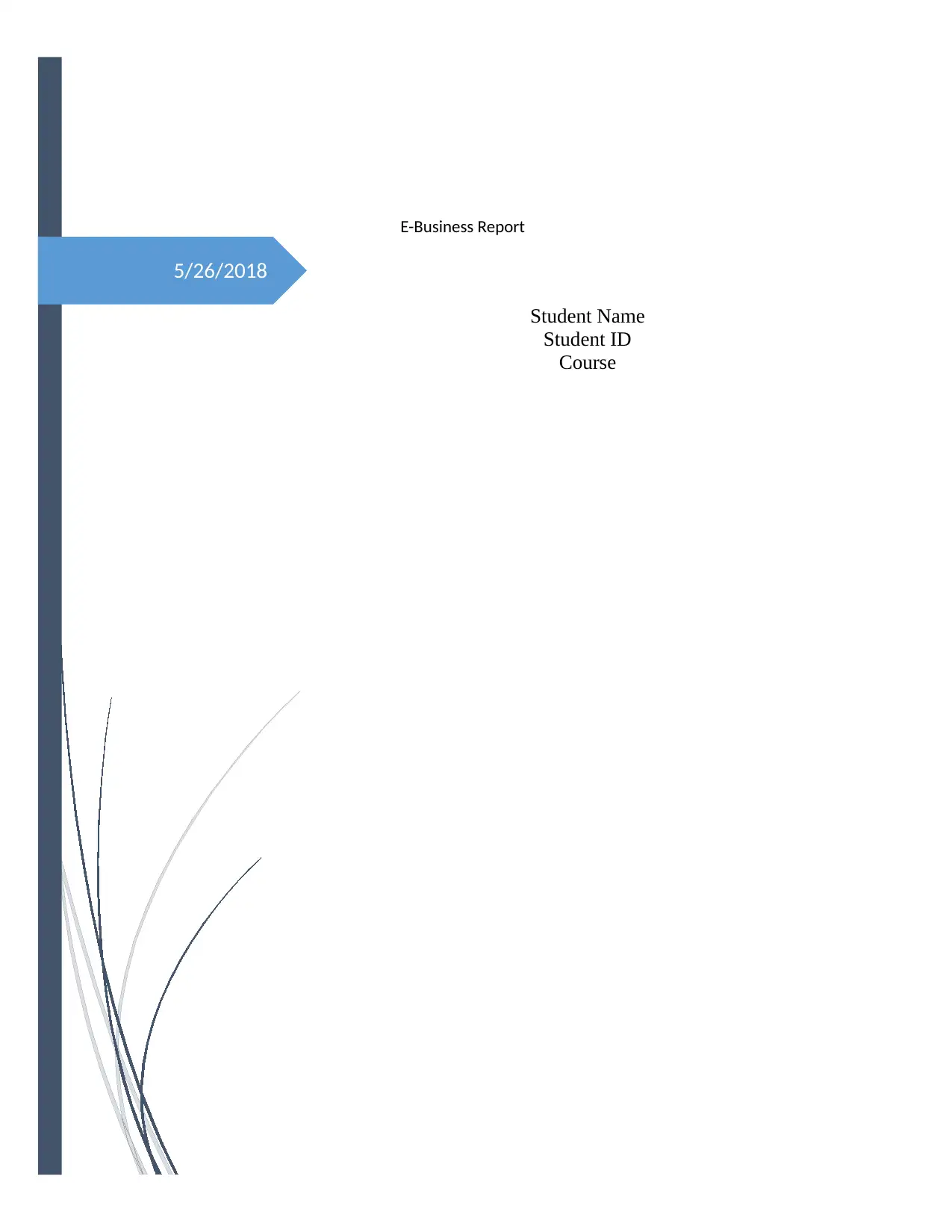
5/26/2018
E-Business Report
Student Name
Student ID
Course
E-Business Report
Student Name
Student ID
Course
Paraphrase This Document
Need a fresh take? Get an instant paraphrase of this document with our AI Paraphraser
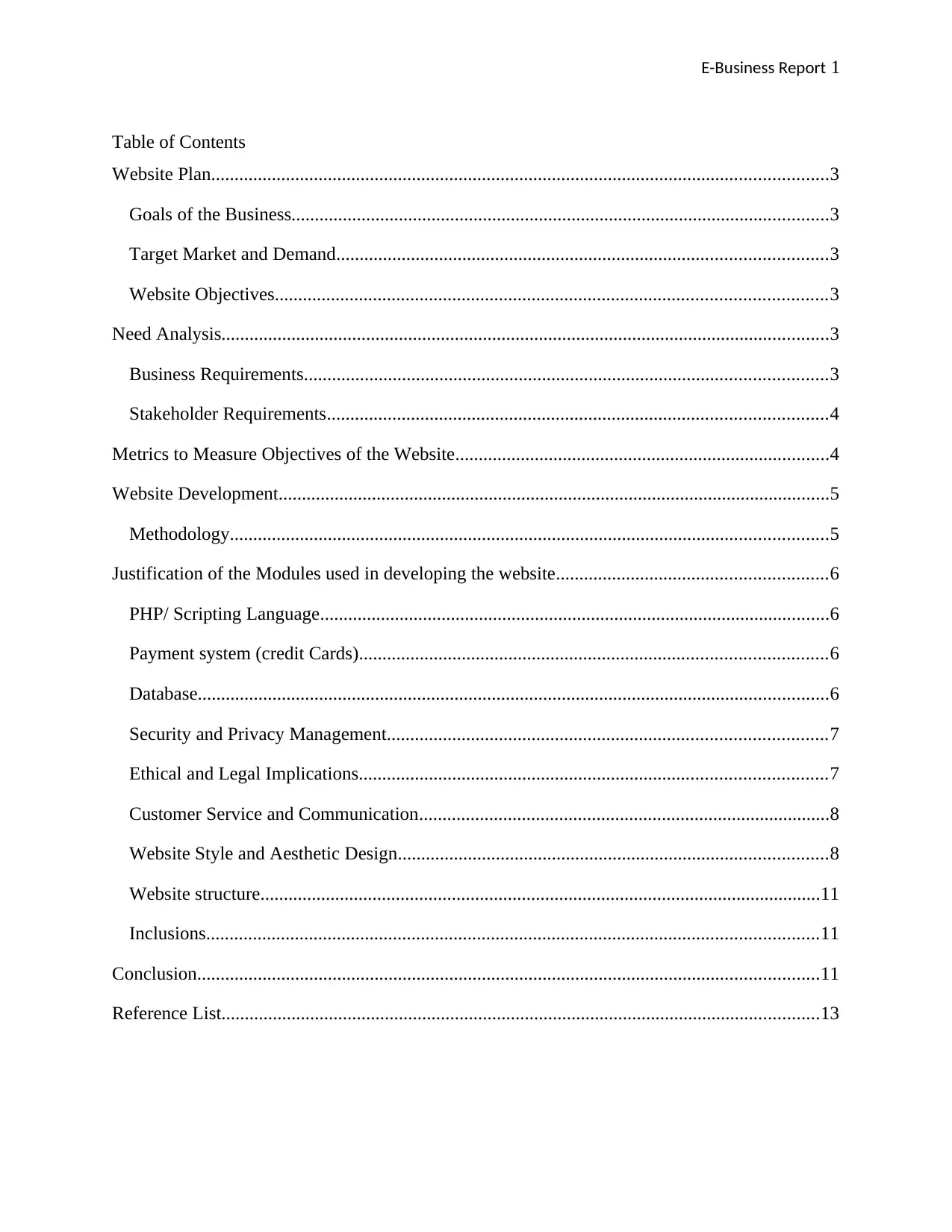
E-Business Report 1
Table of Contents
Website Plan....................................................................................................................................3
Goals of the Business...................................................................................................................3
Target Market and Demand.........................................................................................................3
Website Objectives......................................................................................................................3
Need Analysis..................................................................................................................................3
Business Requirements................................................................................................................3
Stakeholder Requirements...........................................................................................................4
Metrics to Measure Objectives of the Website................................................................................4
Website Development......................................................................................................................5
Methodology................................................................................................................................5
Justification of the Modules used in developing the website..........................................................6
PHP/ Scripting Language.............................................................................................................6
Payment system (credit Cards)....................................................................................................6
Database.......................................................................................................................................6
Security and Privacy Management..............................................................................................7
Ethical and Legal Implications....................................................................................................7
Customer Service and Communication........................................................................................8
Website Style and Aesthetic Design............................................................................................8
Website structure........................................................................................................................11
Inclusions...................................................................................................................................11
Conclusion.....................................................................................................................................11
Reference List................................................................................................................................13
Table of Contents
Website Plan....................................................................................................................................3
Goals of the Business...................................................................................................................3
Target Market and Demand.........................................................................................................3
Website Objectives......................................................................................................................3
Need Analysis..................................................................................................................................3
Business Requirements................................................................................................................3
Stakeholder Requirements...........................................................................................................4
Metrics to Measure Objectives of the Website................................................................................4
Website Development......................................................................................................................5
Methodology................................................................................................................................5
Justification of the Modules used in developing the website..........................................................6
PHP/ Scripting Language.............................................................................................................6
Payment system (credit Cards)....................................................................................................6
Database.......................................................................................................................................6
Security and Privacy Management..............................................................................................7
Ethical and Legal Implications....................................................................................................7
Customer Service and Communication........................................................................................8
Website Style and Aesthetic Design............................................................................................8
Website structure........................................................................................................................11
Inclusions...................................................................................................................................11
Conclusion.....................................................................................................................................11
Reference List................................................................................................................................13
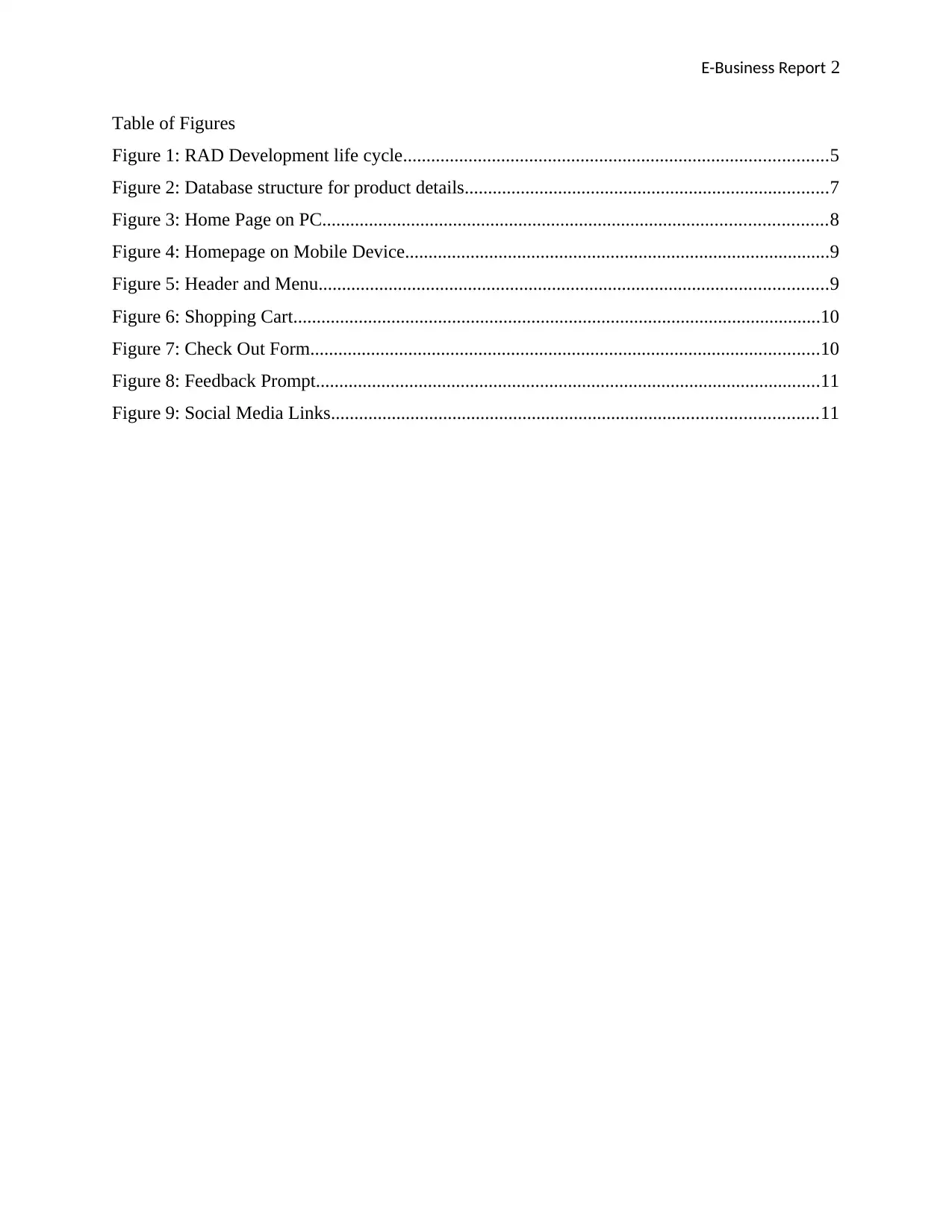
E-Business Report 2
Table of Figures
Figure 1: RAD Development life cycle...........................................................................................5
Figure 2: Database structure for product details..............................................................................7
Figure 3: Home Page on PC............................................................................................................8
Figure 4: Homepage on Mobile Device...........................................................................................9
Figure 5: Header and Menu.............................................................................................................9
Figure 6: Shopping Cart.................................................................................................................10
Figure 7: Check Out Form.............................................................................................................10
Figure 8: Feedback Prompt............................................................................................................11
Figure 9: Social Media Links........................................................................................................11
Table of Figures
Figure 1: RAD Development life cycle...........................................................................................5
Figure 2: Database structure for product details..............................................................................7
Figure 3: Home Page on PC............................................................................................................8
Figure 4: Homepage on Mobile Device...........................................................................................9
Figure 5: Header and Menu.............................................................................................................9
Figure 6: Shopping Cart.................................................................................................................10
Figure 7: Check Out Form.............................................................................................................10
Figure 8: Feedback Prompt............................................................................................................11
Figure 9: Social Media Links........................................................................................................11
⊘ This is a preview!⊘
Do you want full access?
Subscribe today to unlock all pages.

Trusted by 1+ million students worldwide
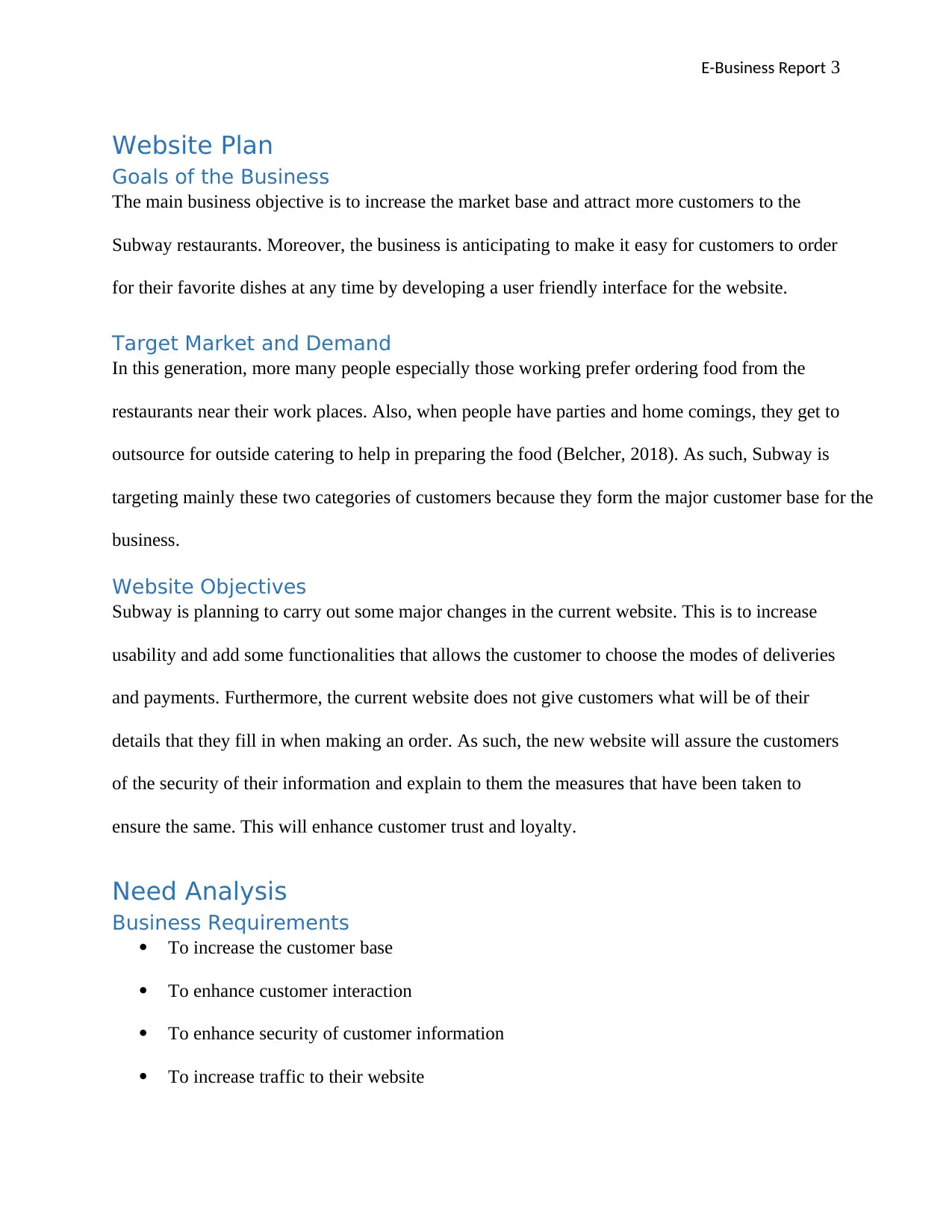
E-Business Report 3
Website Plan
Goals of the Business
The main business objective is to increase the market base and attract more customers to the
Subway restaurants. Moreover, the business is anticipating to make it easy for customers to order
for their favorite dishes at any time by developing a user friendly interface for the website.
Target Market and Demand
In this generation, more many people especially those working prefer ordering food from the
restaurants near their work places. Also, when people have parties and home comings, they get to
outsource for outside catering to help in preparing the food (Belcher, 2018). As such, Subway is
targeting mainly these two categories of customers because they form the major customer base for the
business.
Website Objectives
Subway is planning to carry out some major changes in the current website. This is to increase
usability and add some functionalities that allows the customer to choose the modes of deliveries
and payments. Furthermore, the current website does not give customers what will be of their
details that they fill in when making an order. As such, the new website will assure the customers
of the security of their information and explain to them the measures that have been taken to
ensure the same. This will enhance customer trust and loyalty.
Need Analysis
Business Requirements
To increase the customer base
To enhance customer interaction
To enhance security of customer information
To increase traffic to their website
Website Plan
Goals of the Business
The main business objective is to increase the market base and attract more customers to the
Subway restaurants. Moreover, the business is anticipating to make it easy for customers to order
for their favorite dishes at any time by developing a user friendly interface for the website.
Target Market and Demand
In this generation, more many people especially those working prefer ordering food from the
restaurants near their work places. Also, when people have parties and home comings, they get to
outsource for outside catering to help in preparing the food (Belcher, 2018). As such, Subway is
targeting mainly these two categories of customers because they form the major customer base for the
business.
Website Objectives
Subway is planning to carry out some major changes in the current website. This is to increase
usability and add some functionalities that allows the customer to choose the modes of deliveries
and payments. Furthermore, the current website does not give customers what will be of their
details that they fill in when making an order. As such, the new website will assure the customers
of the security of their information and explain to them the measures that have been taken to
ensure the same. This will enhance customer trust and loyalty.
Need Analysis
Business Requirements
To increase the customer base
To enhance customer interaction
To enhance security of customer information
To increase traffic to their website
Paraphrase This Document
Need a fresh take? Get an instant paraphrase of this document with our AI Paraphraser
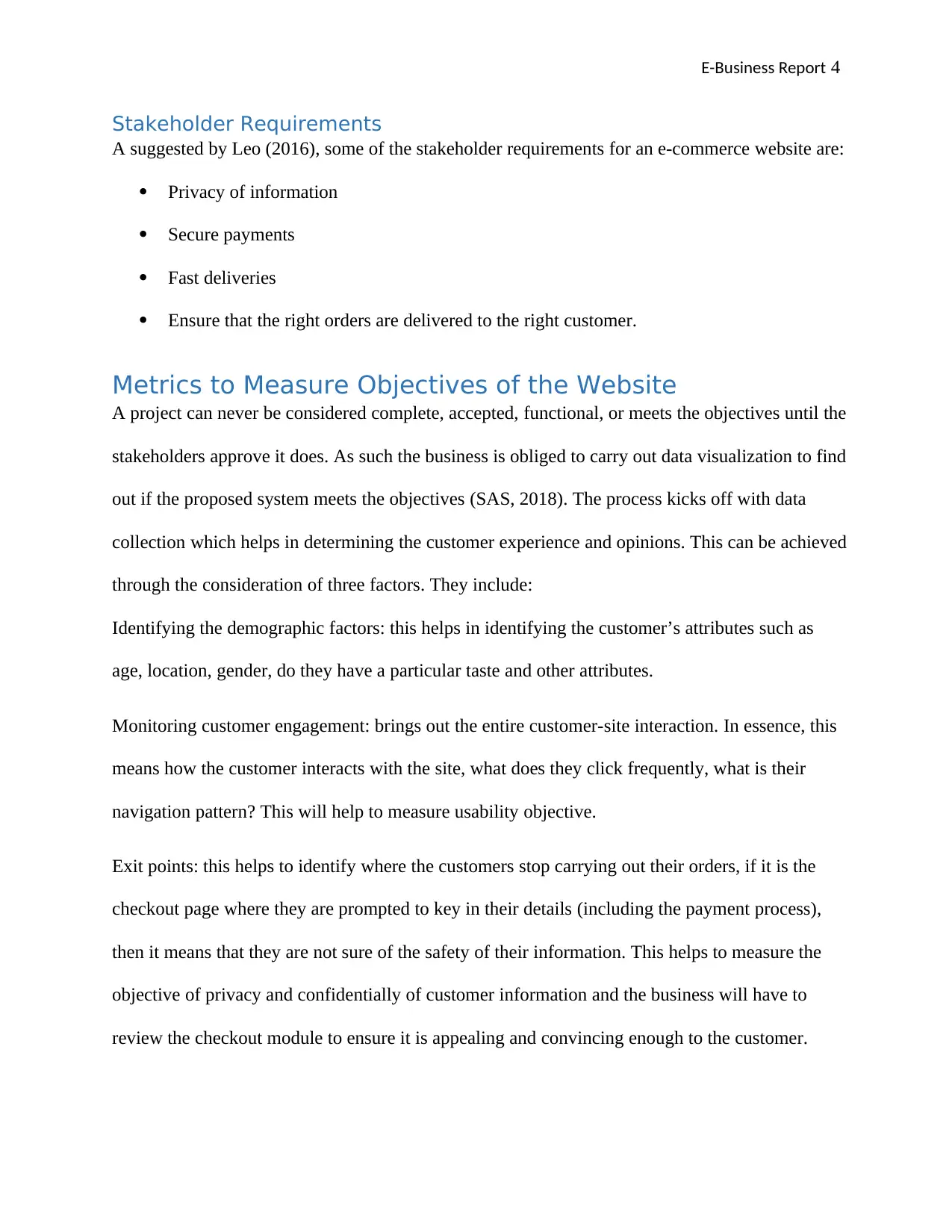
E-Business Report 4
Stakeholder Requirements
A suggested by Leo (2016), some of the stakeholder requirements for an e-commerce website are:
Privacy of information
Secure payments
Fast deliveries
Ensure that the right orders are delivered to the right customer.
Metrics to Measure Objectives of the Website
A project can never be considered complete, accepted, functional, or meets the objectives until the
stakeholders approve it does. As such the business is obliged to carry out data visualization to find
out if the proposed system meets the objectives (SAS, 2018). The process kicks off with data
collection which helps in determining the customer experience and opinions. This can be achieved
through the consideration of three factors. They include:
Identifying the demographic factors: this helps in identifying the customer’s attributes such as
age, location, gender, do they have a particular taste and other attributes.
Monitoring customer engagement: brings out the entire customer-site interaction. In essence, this
means how the customer interacts with the site, what does they click frequently, what is their
navigation pattern? This will help to measure usability objective.
Exit points: this helps to identify where the customers stop carrying out their orders, if it is the
checkout page where they are prompted to key in their details (including the payment process),
then it means that they are not sure of the safety of their information. This helps to measure the
objective of privacy and confidentially of customer information and the business will have to
review the checkout module to ensure it is appealing and convincing enough to the customer.
Stakeholder Requirements
A suggested by Leo (2016), some of the stakeholder requirements for an e-commerce website are:
Privacy of information
Secure payments
Fast deliveries
Ensure that the right orders are delivered to the right customer.
Metrics to Measure Objectives of the Website
A project can never be considered complete, accepted, functional, or meets the objectives until the
stakeholders approve it does. As such the business is obliged to carry out data visualization to find
out if the proposed system meets the objectives (SAS, 2018). The process kicks off with data
collection which helps in determining the customer experience and opinions. This can be achieved
through the consideration of three factors. They include:
Identifying the demographic factors: this helps in identifying the customer’s attributes such as
age, location, gender, do they have a particular taste and other attributes.
Monitoring customer engagement: brings out the entire customer-site interaction. In essence, this
means how the customer interacts with the site, what does they click frequently, what is their
navigation pattern? This will help to measure usability objective.
Exit points: this helps to identify where the customers stop carrying out their orders, if it is the
checkout page where they are prompted to key in their details (including the payment process),
then it means that they are not sure of the safety of their information. This helps to measure the
objective of privacy and confidentially of customer information and the business will have to
review the checkout module to ensure it is appealing and convincing enough to the customer.
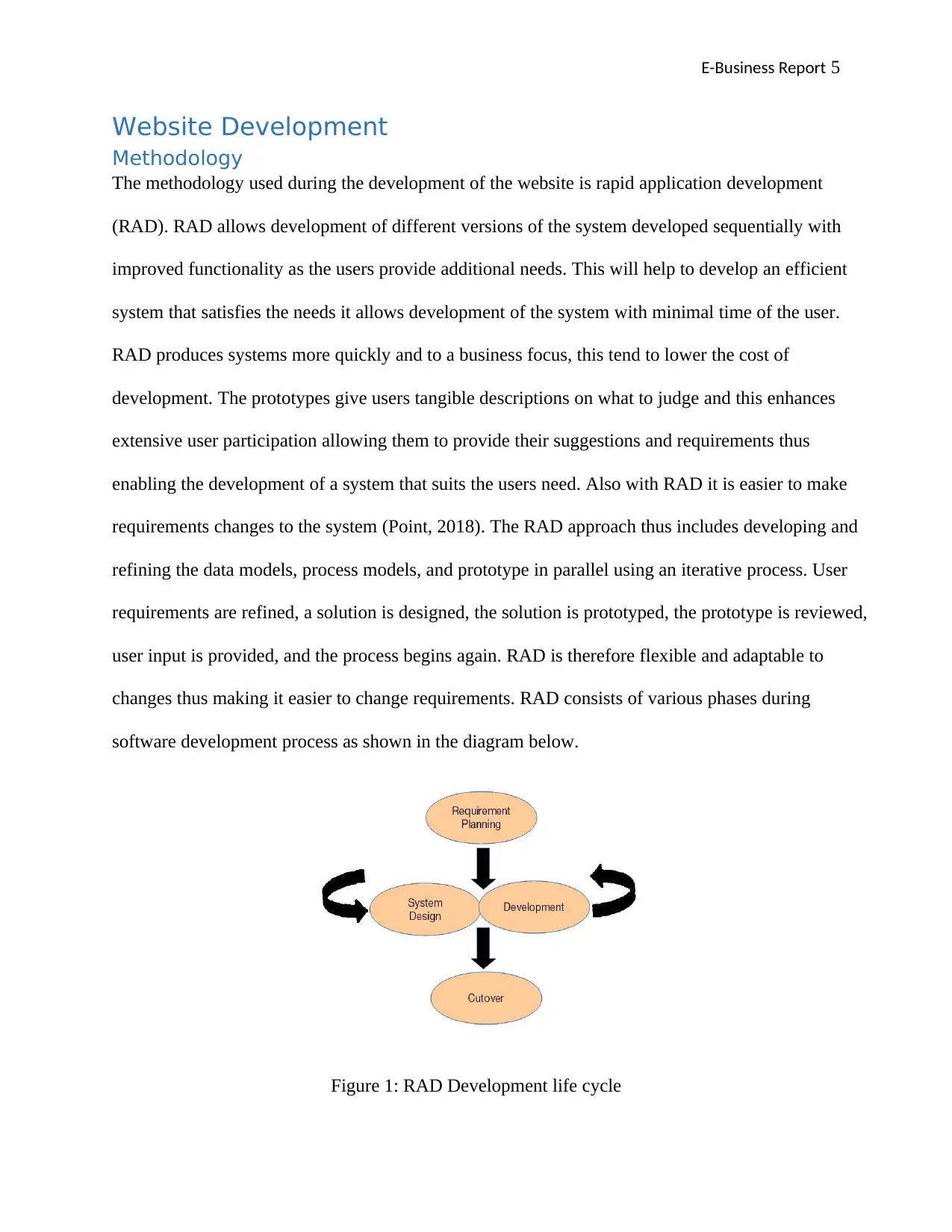
E-Business Report 5
Website Development
Methodology
The methodology used during the development of the website is rapid application development
(RAD). RAD allows development of different versions of the system developed sequentially with
improved functionality as the users provide additional needs. This will help to develop an efficient
system that satisfies the needs it allows development of the system with minimal time of the user.
RAD produces systems more quickly and to a business focus, this tend to lower the cost of
development. The prototypes give users tangible descriptions on what to judge and this enhances
extensive user participation allowing them to provide their suggestions and requirements thus
enabling the development of a system that suits the users need. Also with RAD it is easier to make
requirements changes to the system (Point, 2018). The RAD approach thus includes developing and
refining the data models, process models, and prototype in parallel using an iterative process. User
requirements are refined, a solution is designed, the solution is prototyped, the prototype is reviewed,
user input is provided, and the process begins again. RAD is therefore flexible and adaptable to
changes thus making it easier to change requirements. RAD consists of various phases during
software development process as shown in the diagram below.
Figure 1: RAD Development life cycle
Website Development
Methodology
The methodology used during the development of the website is rapid application development
(RAD). RAD allows development of different versions of the system developed sequentially with
improved functionality as the users provide additional needs. This will help to develop an efficient
system that satisfies the needs it allows development of the system with minimal time of the user.
RAD produces systems more quickly and to a business focus, this tend to lower the cost of
development. The prototypes give users tangible descriptions on what to judge and this enhances
extensive user participation allowing them to provide their suggestions and requirements thus
enabling the development of a system that suits the users need. Also with RAD it is easier to make
requirements changes to the system (Point, 2018). The RAD approach thus includes developing and
refining the data models, process models, and prototype in parallel using an iterative process. User
requirements are refined, a solution is designed, the solution is prototyped, the prototype is reviewed,
user input is provided, and the process begins again. RAD is therefore flexible and adaptable to
changes thus making it easier to change requirements. RAD consists of various phases during
software development process as shown in the diagram below.
Figure 1: RAD Development life cycle
⊘ This is a preview!⊘
Do you want full access?
Subscribe today to unlock all pages.

Trusted by 1+ million students worldwide
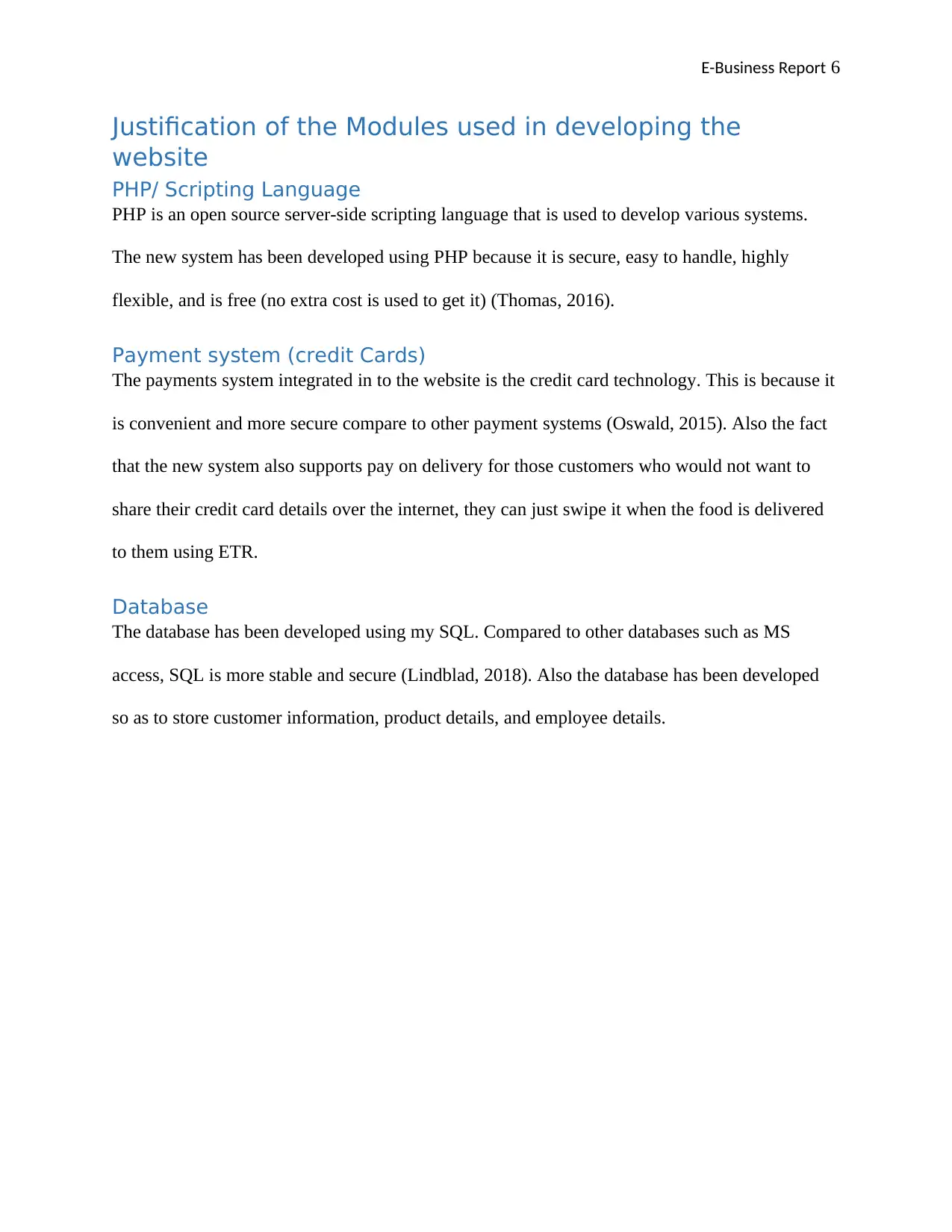
E-Business Report 6
Justification of the Modules used in developing the
website
PHP/ Scripting Language
PHP is an open source server-side scripting language that is used to develop various systems.
The new system has been developed using PHP because it is secure, easy to handle, highly
flexible, and is free (no extra cost is used to get it) (Thomas, 2016).
Payment system (credit Cards)
The payments system integrated in to the website is the credit card technology. This is because it
is convenient and more secure compare to other payment systems (Oswald, 2015). Also the fact
that the new system also supports pay on delivery for those customers who would not want to
share their credit card details over the internet, they can just swipe it when the food is delivered
to them using ETR.
Database
The database has been developed using my SQL. Compared to other databases such as MS
access, SQL is more stable and secure (Lindblad, 2018). Also the database has been developed
so as to store customer information, product details, and employee details.
Justification of the Modules used in developing the
website
PHP/ Scripting Language
PHP is an open source server-side scripting language that is used to develop various systems.
The new system has been developed using PHP because it is secure, easy to handle, highly
flexible, and is free (no extra cost is used to get it) (Thomas, 2016).
Payment system (credit Cards)
The payments system integrated in to the website is the credit card technology. This is because it
is convenient and more secure compare to other payment systems (Oswald, 2015). Also the fact
that the new system also supports pay on delivery for those customers who would not want to
share their credit card details over the internet, they can just swipe it when the food is delivered
to them using ETR.
Database
The database has been developed using my SQL. Compared to other databases such as MS
access, SQL is more stable and secure (Lindblad, 2018). Also the database has been developed
so as to store customer information, product details, and employee details.
Paraphrase This Document
Need a fresh take? Get an instant paraphrase of this document with our AI Paraphraser
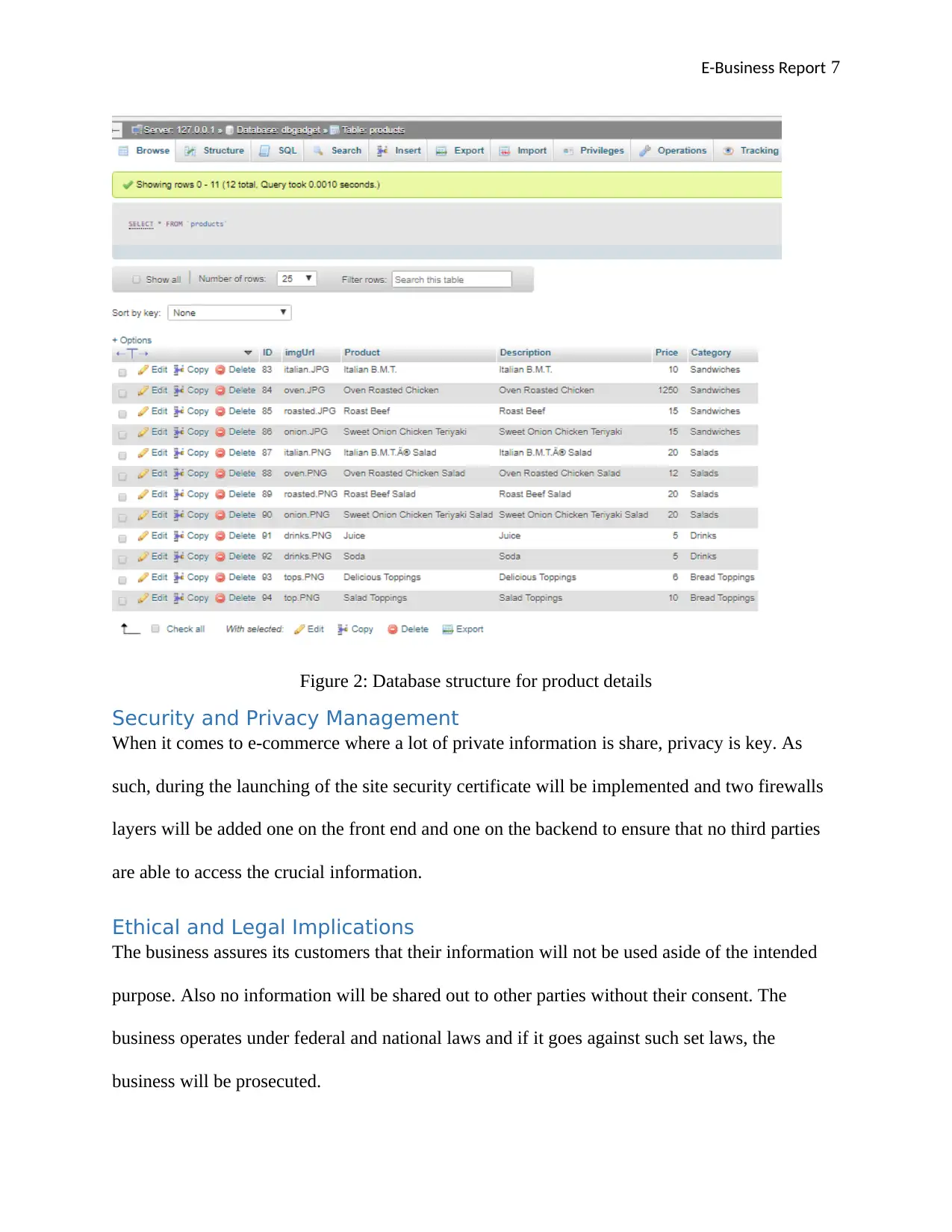
E-Business Report 7
Figure 2: Database structure for product details
Security and Privacy Management
When it comes to e-commerce where a lot of private information is share, privacy is key. As
such, during the launching of the site security certificate will be implemented and two firewalls
layers will be added one on the front end and one on the backend to ensure that no third parties
are able to access the crucial information.
Ethical and Legal Implications
The business assures its customers that their information will not be used aside of the intended
purpose. Also no information will be shared out to other parties without their consent. The
business operates under federal and national laws and if it goes against such set laws, the
business will be prosecuted.
Figure 2: Database structure for product details
Security and Privacy Management
When it comes to e-commerce where a lot of private information is share, privacy is key. As
such, during the launching of the site security certificate will be implemented and two firewalls
layers will be added one on the front end and one on the backend to ensure that no third parties
are able to access the crucial information.
Ethical and Legal Implications
The business assures its customers that their information will not be used aside of the intended
purpose. Also no information will be shared out to other parties without their consent. The
business operates under federal and national laws and if it goes against such set laws, the
business will be prosecuted.
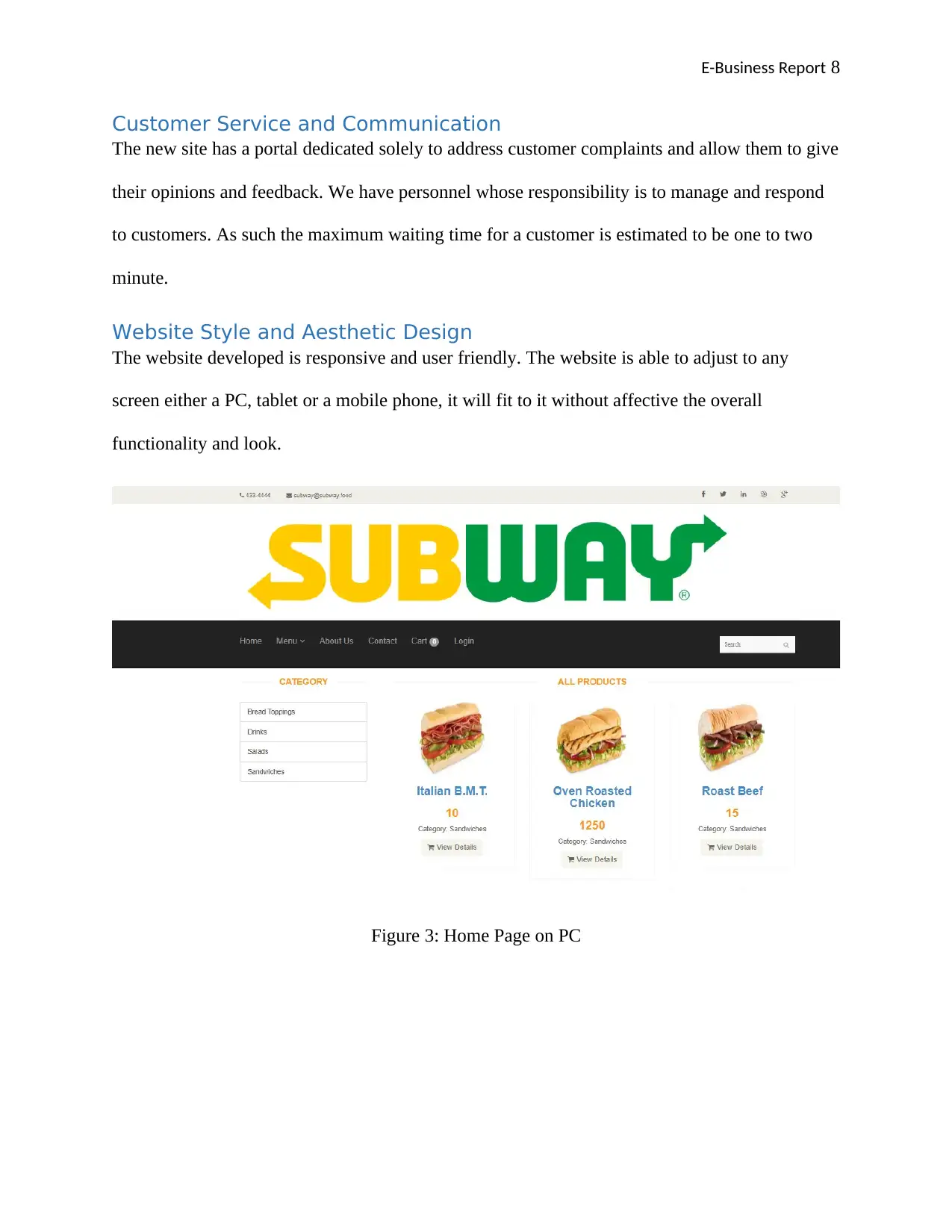
E-Business Report 8
Customer Service and Communication
The new site has a portal dedicated solely to address customer complaints and allow them to give
their opinions and feedback. We have personnel whose responsibility is to manage and respond
to customers. As such the maximum waiting time for a customer is estimated to be one to two
minute.
Website Style and Aesthetic Design
The website developed is responsive and user friendly. The website is able to adjust to any
screen either a PC, tablet or a mobile phone, it will fit to it without affective the overall
functionality and look.
Figure 3: Home Page on PC
Customer Service and Communication
The new site has a portal dedicated solely to address customer complaints and allow them to give
their opinions and feedback. We have personnel whose responsibility is to manage and respond
to customers. As such the maximum waiting time for a customer is estimated to be one to two
minute.
Website Style and Aesthetic Design
The website developed is responsive and user friendly. The website is able to adjust to any
screen either a PC, tablet or a mobile phone, it will fit to it without affective the overall
functionality and look.
Figure 3: Home Page on PC
⊘ This is a preview!⊘
Do you want full access?
Subscribe today to unlock all pages.

Trusted by 1+ million students worldwide
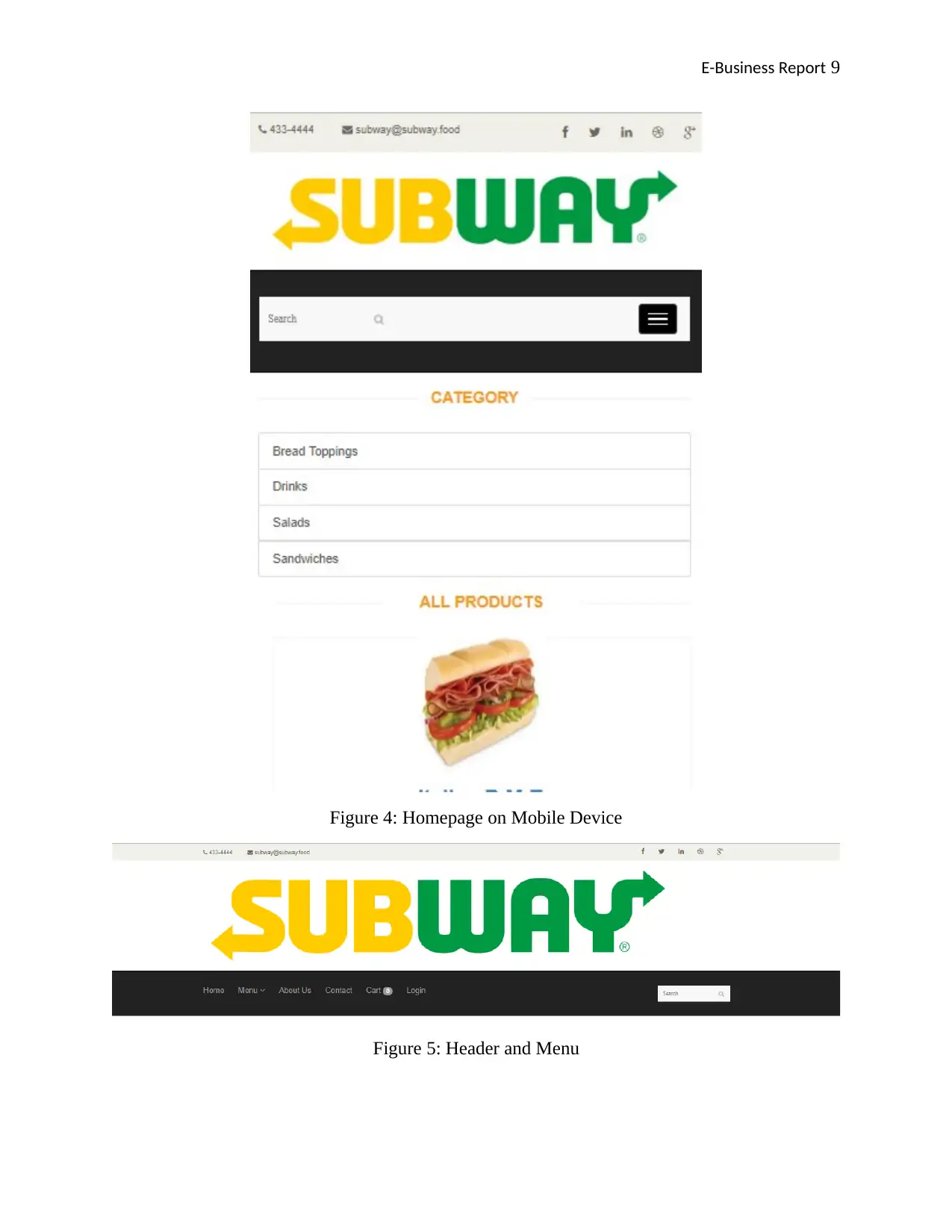
E-Business Report 9
Figure 4: Homepage on Mobile Device
Figure 5: Header and Menu
Figure 4: Homepage on Mobile Device
Figure 5: Header and Menu
Paraphrase This Document
Need a fresh take? Get an instant paraphrase of this document with our AI Paraphraser
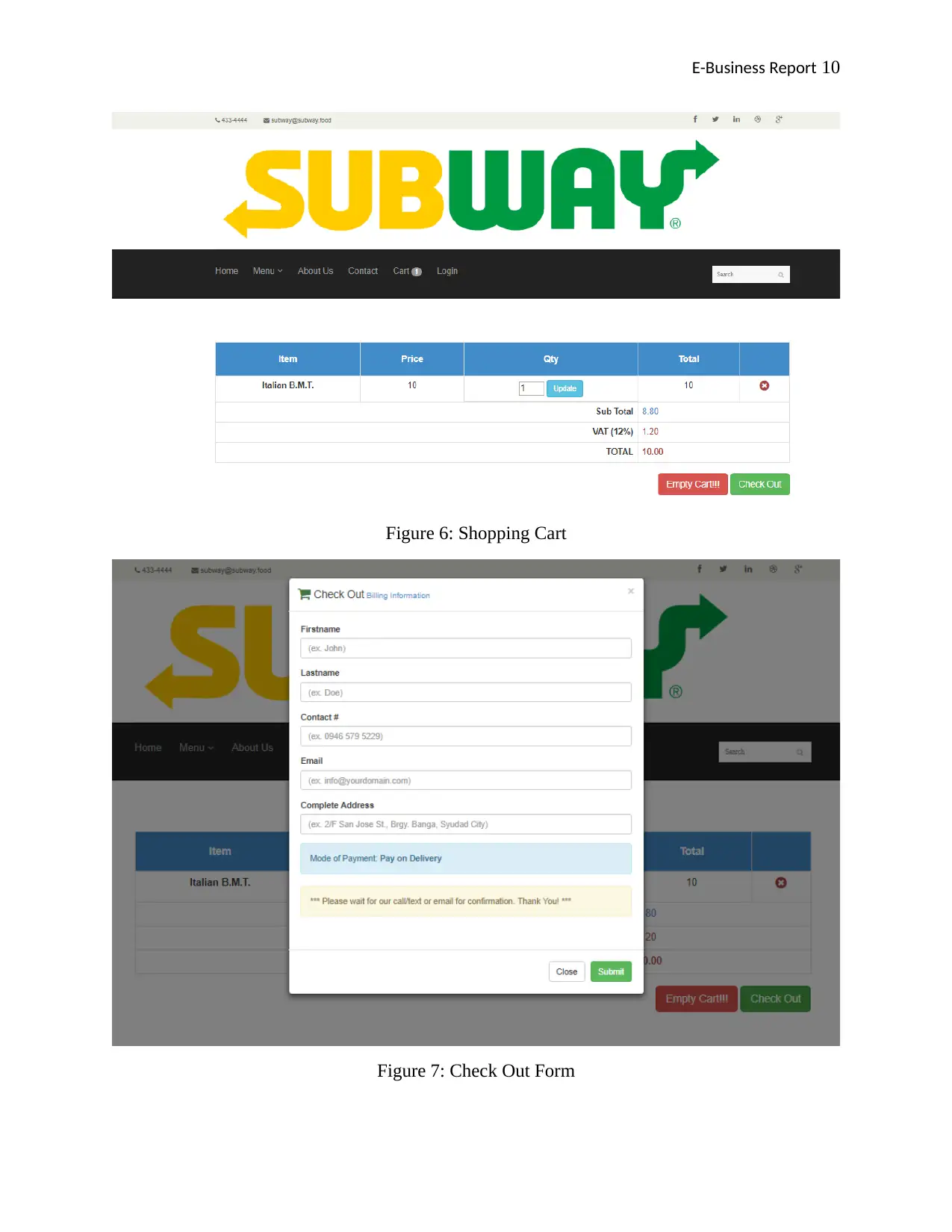
E-Business Report 10
Figure 6: Shopping Cart
Figure 7: Check Out Form
Figure 6: Shopping Cart
Figure 7: Check Out Form
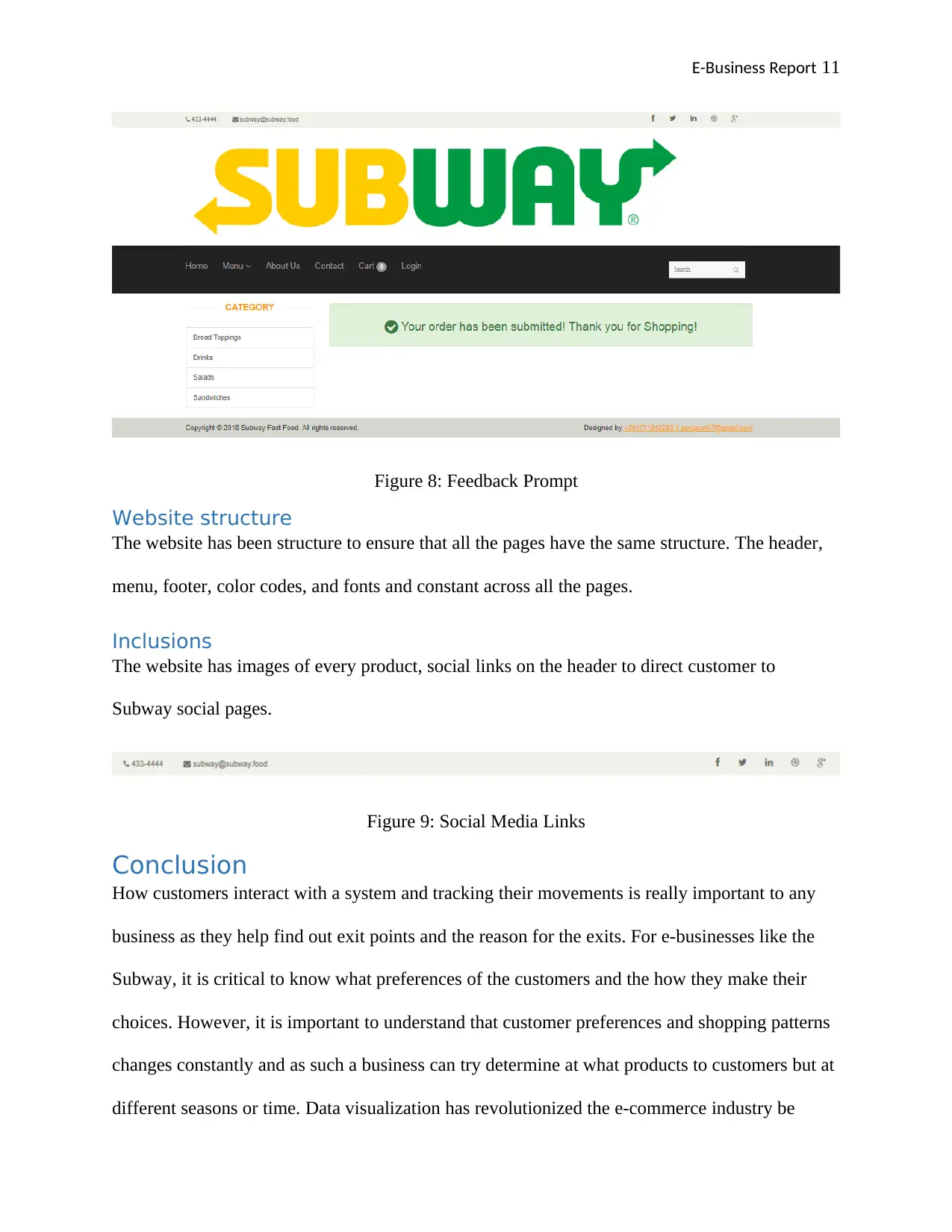
E-Business Report 11
Figure 8: Feedback Prompt
Website structure
The website has been structure to ensure that all the pages have the same structure. The header,
menu, footer, color codes, and fonts and constant across all the pages.
Inclusions
The website has images of every product, social links on the header to direct customer to
Subway social pages.
Figure 9: Social Media Links
Conclusion
How customers interact with a system and tracking their movements is really important to any
business as they help find out exit points and the reason for the exits. For e-businesses like the
Subway, it is critical to know what preferences of the customers and the how they make their
choices. However, it is important to understand that customer preferences and shopping patterns
changes constantly and as such a business can try determine at what products to customers but at
different seasons or time. Data visualization has revolutionized the e-commerce industry be
Figure 8: Feedback Prompt
Website structure
The website has been structure to ensure that all the pages have the same structure. The header,
menu, footer, color codes, and fonts and constant across all the pages.
Inclusions
The website has images of every product, social links on the header to direct customer to
Subway social pages.
Figure 9: Social Media Links
Conclusion
How customers interact with a system and tracking their movements is really important to any
business as they help find out exit points and the reason for the exits. For e-businesses like the
Subway, it is critical to know what preferences of the customers and the how they make their
choices. However, it is important to understand that customer preferences and shopping patterns
changes constantly and as such a business can try determine at what products to customers but at
different seasons or time. Data visualization has revolutionized the e-commerce industry be
⊘ This is a preview!⊘
Do you want full access?
Subscribe today to unlock all pages.

Trusted by 1+ million students worldwide
1 out of 14
Related Documents
Your All-in-One AI-Powered Toolkit for Academic Success.
+13062052269
info@desklib.com
Available 24*7 on WhatsApp / Email
![[object Object]](/_next/static/media/star-bottom.7253800d.svg)
Unlock your academic potential
Copyright © 2020–2025 A2Z Services. All Rights Reserved. Developed and managed by ZUCOL.




